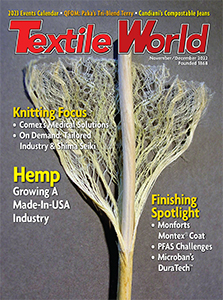By Robert S. Reichard, Economics Editor
Half the year has gone by, and all signs now suggest that 2014 domestic textile and apparel activity — bolstered by a slowly strengthening economy — will equal or even top last year’s advance. Looking at the macroeconomic picture first: Overall demand, which slowed down in the first quarter, now seems headed for a modest second-half pickup. Most business analysts see a close-to-2.5-percent annual rate of growth over the remainder of the year. And that’s pretty much what188BET金博宝下载editors also expect. This encouraging trend should spill over into 2015, with the World Bank already on record calling for a solid 3.5-percent advance for that year.
This kind of pace should guarantee continued employment increases — with an average of more than 200,000 new jobs likely to be added each month through year end and into 2015 — enough to spark further upticks in consumer spending. There are also some other positive signs of stepped-up buying. For one, there’s the continuing increase in household wealth — the value of homes, stocks and other assets, minus debts and other liabilities. At last report, this number was running some 2 percent, or $1.5 trillion, above three-month-earlier levels — enough to push this key buying indicator to a new all-time high. Still another upbeat sign: Americans again seem to be feeling a little more comfortable about borrowing. Thus, overall household debt rose at an annual 2-percent rate in the first quarter — considerably higher than the relatively flat pattern noted during late 2013.

The Textile And Apparel Impact
All the above is good news for the textile and apparel industries. That’s on top of an already solid year-to-date performance. Textile mill dollar shipments are, as of now, up 1 percent compared to early 2013. And if one travels further downstream to the apparel sector, the shipment gain is even more impressive — somewhere near 3 percent. One indication that increases will continue into the remainder of the year — aside from the expected acceleration in general economic growth — come from the Institute of Supply Management. This group’s widely monitored grass-roots survey of the nation’s top purchasing executives finds that textile demand has been fairly brisk in recent months. Still other signs that suggest better days ahead would have to include the continuing leveling-off in imports, and today’s relatively trim inventory levels — now running well under the highs of a few years back. This latter development is especially important because it suggests that new incoming orders are now increasingly likely to be filled via new production rather than by any stock drawdowns. Given all the above, TW editors now feel mill shipments for the year as a whole could rise as much as 3 percent. Basic mill items like yarns and fabrics will probably lead the advance, with more highly fabricated items like home furnishings and carpets expected to hold near last year’s levels. As for apparel, TW now sees 2014 shipment totals running anywhere from 3 to 4 percent above 2013 levels.
更好的底线
这些预期的需求收益将有助于提高收入。诸如稳定的确保价格和成本保持较低或低于年度阅读量之类的其他因素也是如此。确实,已经有一些很好的证据表明利润已经成为去年同期的最高水平。因此,第一季度税后工厂的收益比一年前报告的收益领先20%,就磨坊利润率而言,一年一度的改善同样令人印象深刻。现在,每美元销售数量的最新利润估计为3.9%,远高于年度读数3.3%的阅读。当将利润与美元的股东权益进行比较时,同样的阳性情况也会记录到 - 这里的最新磨坊数量为8.7美分,而去年同期仅为7.7美分。更重要的是,经济咨询公司Global Insight看到了上升收益趋势的持续。例如,制造基本纺织品产品的磨坊的利润收益应为2.5%左右 - 2015年和2016年的增长率更高。零制造的磨坊产品零,并且增加的增长应该更令人印象深刻,在2014 - 16年度期间平均以超过5%的速度。含义:未来的健康和可行的国内纺织品和服装行业。
July/August 2014




